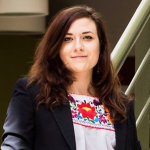In this project we will train a large machine learning model to represent MIDI music events natively. This strikes a balance between representing music as raw audio, which is expensive and poorly interpretable and representing it symbolically, which introduces implicit biases, and reduces the amount of available data. This allows us, among other things to investigate the impact of biases toward western music in the data, and to see how well a model like this generalizes outside of its training distribution.
Researchers:
-

-
Peter Bloem
-

-
Emily Clark
Students:

Dragos-Andrei Pop

Bas Maat

Michał Butkiewicz
ICT is integral to modern societies as our digital and physical realities are increasingly interwoven. Societal digitalization is coupled with cloud computing, generating an ever growing need for more data storage and computing capacity. Unfortunately, cloud provisioning too often prioritises economic gain over the cost of long-lasting environmental and social sustainability.
This project researches the sustainability of cloud computing, by identifying the related social, technical and environmental risks and benefits, and complementing them with examples of possible countermeasures. We look at data-centers and cloud provisioning from an interdisciplinary perspective, using approaches and methods from the social and technical sciences to understand and tackle the problem in a holistic manner for identifying the building-blocks for future data-centers and their contribution to a sustainable digital society.
We are zooming in on three research questions: What are the societal practices, risks and benefits in the cloud-ecosystem? What are the technical cloud solutions, current and future, that could address (or hinder) societal sustainability of a cloud-based digital society? And, what are the possible countermeasures to the identified risks or (negative) practices that hinder a sustainable adoption of the cloud? It is a collaboration between researchers in the S2 Group and IVM and is expected to yield a holistic understanding of the interaction between digitalization of society, migration to the cloud, and socio-ecological impacts.
Researchers:
-

-
Patricia Lago
-

-
Oscar Widerberg
Students:
-

-
Floris de Jong
-

-
Anna Bessin
Museums play an important role in guiding people’s societal perceptions of cultures and histories. Large parts of historical collections, particularly in the Netherlands, are a legacy of the colonial past. There have been increasing efforts to make sure that museums not only acknowledge, but also reveal to visitors the multiple (e.g. cultural) meanings and context that are attached to these objects (i.e., polyvocality).
But how can museums achieve this? By bridging Computer Science, Communication Science, and the Humanities, and extending the groundwork of the Pressing Matter project, this NIAA project will investigate new ways for visitors to interact with (colonial) objects in virtual reality. We will develop a “satellite” exhibit in virtual reality of an actual exhibition, hosted at the VU, and assess how it affects visitors’ interaction with colonial objects, and might diversify visitors’ views on the colonial past, by applying a mixed-methods evaluation, including qualitative (in-depth interviews), and quantitative (survey, tracked user) data.
Researchers:
-

-
Claudia Libbi
-

-
Tilo Hartmann
Students:
-

-
Stefania Conte
-

-
Isabel Florence Franke
The spatial organization of cells underlies and influences the function of many biological systems, including tumors. Emerging biotechnologies now allow for spatially resolved quantification of transcriptomes at single cell resolution, but such technologies are expensive and relatively low-throughput. On the other hand, conventional single cell or single nucleus RNA-sequencing based technologies are now routinely applied to obtain genome-wide transcriptome profiles in hundreds of thousands to millions of cells, but do not retain spatial information.
The aim of this project is to employ deep generative models to reconstruct the spatial structure of biological samples from single cell transcriptomic count data alone. If successful, this project will allow for augmentation of single cell transcriptomics dataset with meaningful spatial information (e.g. extent of immune infiltration in tumor), adding great value to such datasets.
Researchers:
-

-
Evert Bosdriesz
-

-
Jakub M. Tomczak
Students:
-

-
Robert Ioiart
-

-
Lisa de Groot
This project will investigate the use of deceptive and manipulative design (also calleddark patterns) in privacy policy notices of websites, and how they affect the concrete implementation of the transparency principle enshrined in the General Data Protection Regulation (GDPR).
We will look at how deceptive design interacts with the principle of transparency under the GDPR from a legal perspective, specifically with the concrete forms in which the right of information is implemented, and their compatibility with the GDPR in general. The project will also develop a technical tool to analyse privacy policies and “benchmark” deceptive design techniques across different data controller sectors (e.g., social networks, internet banking, newspapers).
Researchers:
-

-
Dayana Spagnuelo
-

-
Silvia De Conca
Students;
-

-
Krishna Mukesh Shukla
-

-
Marit Blank
Although software testing is key to a safe society, the process itself is often perceived as a stressful and boring chore. The adverse effect is a suboptimal testing that might leave wicked dangerous, bugs undetected. A better understanding of what testers “feel” can remedy this situation.
The question is how to measure what testers feel? Students who worked with DBugIT/BugZoo, an innovative tool developed at the VU for teaching software testing, reported feelings such as boredom and stress for not finding bugs, excitement when finding a bug, and a drive to continue testing to find more.
This project will use AI and various physiological wearable sensors (with a focus on measuring cardiac activity and skin conductance) to recognize in real-time the emotions of testers at work. Based on the inferred emotion, an adaptive bio-feedback will emerge, to encourage testers to continue their work in optimal conditions. Although AI-enabled emotion recognition is not new, applying it in the particular field of software testing teaching is to our knowledge, innovative. When successful, this challenging project will contribute to a more inspiring and motivating environment for testers in academia and IT industry, and eventually to high-quality software we all can rely on.
Researchers:
-

-
Natalia Silvis-Cividjian
-

-
Martin Gevonden
Students:
-

-
Stijn Sluis
-

-
Elina Nazarian
The use of automatic face analysis is rapidly spreading in our society. This technology, like facial recognition, is primarily used for security and law enforcement purposes, but it is now becoming popular in other areas, like in recruitment, education and analysis of facial expression. However, facial recognition systems are consistently built on a gender binary construct and almost never take into account individuals who identify non-binary. As a consequence, these types of human-machine interfaces reinforce existing prejudices about these communities. By considering essential questions about the conditions under which digitalization creates knowledge and identities, the hypothesis underlying the research project is that in facial recognition system non-binary databases are missing.
Facing this phenomenon, the goal of the project is to lay the groundwork for a critical study on the relationships among gender, identity and face recognition technologies. The aim is twofold: i) enhancing the visibility of non-binary identities, as the representativeness of minority communities is the foundation of fair AI system; ii) studying the dichotomy between self-perceived gender vs machine-classified gender through an analysis of the current face recognition algorithms.
In more detail, the project is structured as follows: i) visual archives analysis: morphosyntactic analysis of facial images of historical (e.g.: IHLIA) and personal archives from individuals of the non-binary communities; ii) prolegomena for a future gender fair: construction of a dataset by cataloging patterns that contribute to gender self-perception; iii) analysis of facial recognition algorithms: an interdisciplinary study of patterns contributing to self-perceived gender and to machine-classified gender.
Researchers:
-

-
Elena Beretta
-

-
Ayse Seda Yalcin-Muftugil
-

-
Cristina Voto
Students:
-

-
Soumyankar Mohapatra
-

-
Montse Ollés Roig






























